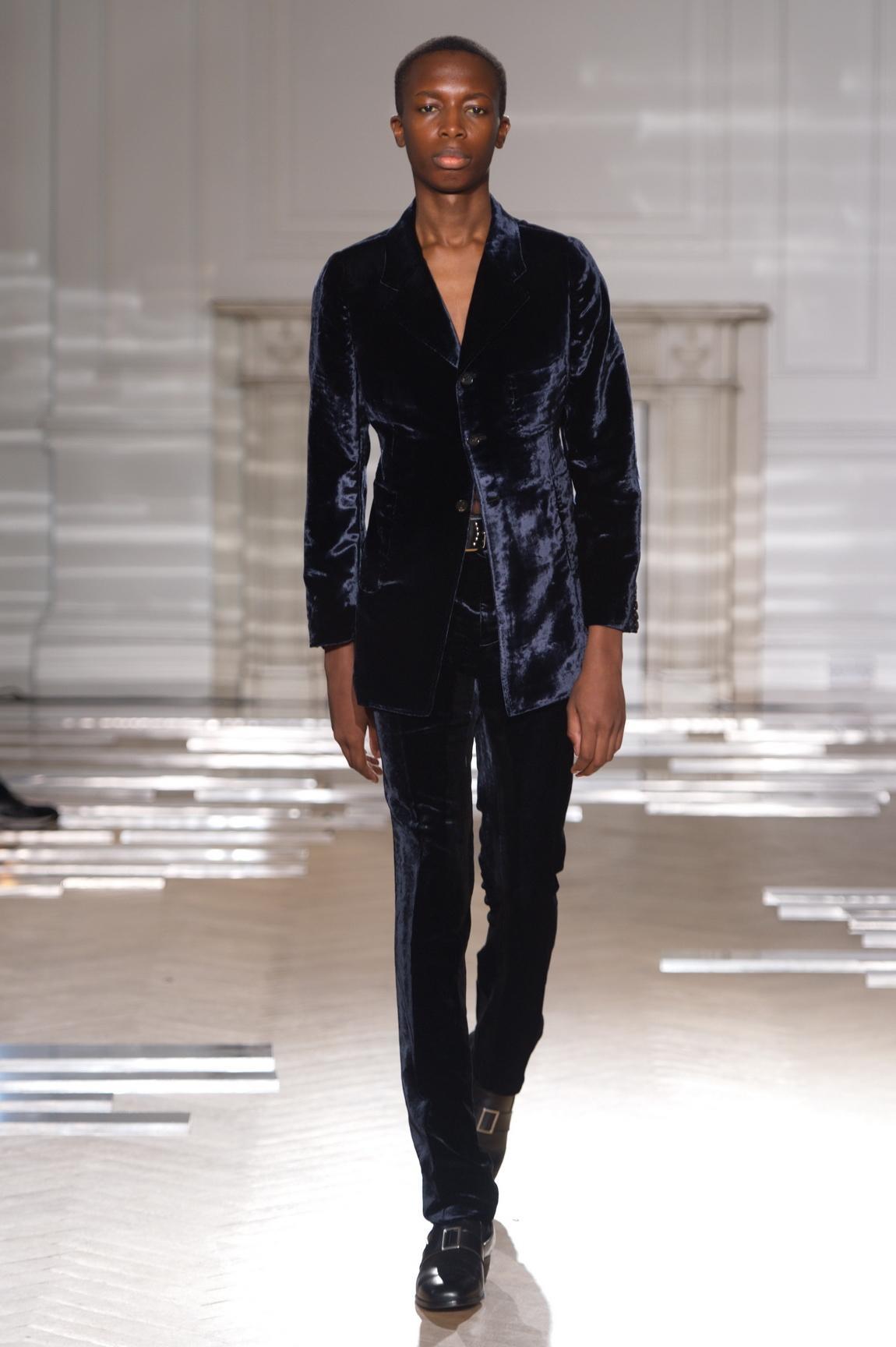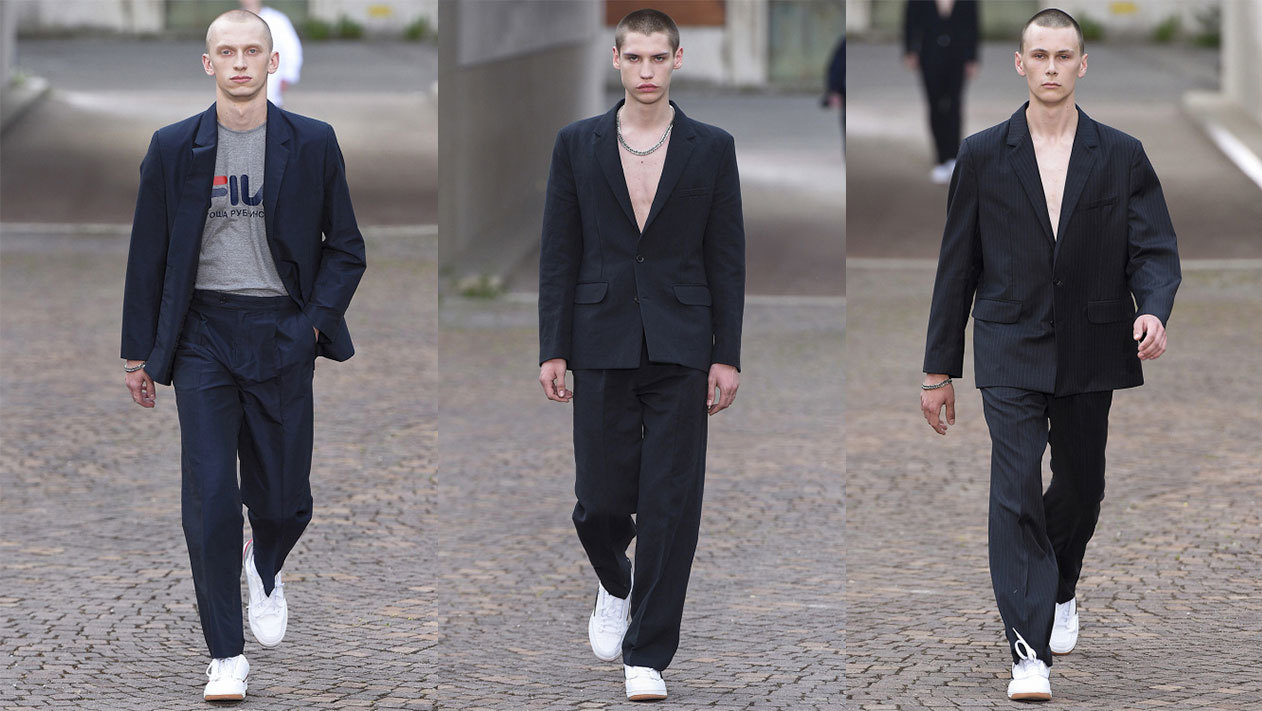Gosha Rubchinskiy’s show for spring/summer 17 at Pitti Uomo began with a triptych of boys marching through the Fascist architecture of a Florentine tobacco factory. The first two boys were shirtless, the second had a thick chain around his neck. All three were dressed in dark, subtle suits, and consequently, Instagram broke before our eyes.
Arguably, it wasn’t an unexpected move for Gosha to introduce tailoring for Pitti. But in its immediate impact, it felt like a sensational gesture for a Russian designer so entrenched in the sportswear-and-tracksuit aesthetic of post-Soviet youth.
After all, what does streetwear try to do, if not to distance itself from the tailored uniformity of the professional, or his antipode, the school kid? But maybe, in this world of feedback loops, we’re nearing the end of our romance with streetwear? Maybe it’s become too ubiquitous — too readily reduced to a mannerism instead of a thought. Maybe it’s been called something embarrassing like “athleisure” too often.
By no means does a suit simply mark a new maturity in the Gosha muse, or the closing chapter of his bildungsroman. Instead, it is part of the shifted emphasis on suits that has emerged recently, and was definitely consolidated over spring/summer 17 menswear season by some of the designers most authentically tied to youth mentality. With his current degree of influence, Demna Gvasalia’s creative direction for both Vetements and Balenciaga are at the forefront of this discussion; arguably most integral is Raf Simons, whose clothes have always been characterized by both tailored shapes and representations of what he calls “the fourth sex” (adolescence). Off-White and J.W. Anderson, too, should be mentioned, and Grace Wales Bonner, whose revolutionary tailored take on black masculinity and identity won her the LVMH prize this year.

Charles Jeffrey’s LOVERBOY label, like Grace’s, emerged through Fashion East and MAN to establish a club kid aesthetic focusing on perversions of tailoring in order to challenge traditional expectations of the male body. He drapes, gathers, and tortures the clothes with a flamboyant echo of the New Romantics.
In its purist form, the modern lounge suit (aka the business suit) is built on codes of homogeneity, heterosexuality, masculinity, formality, and social status. And so, any changes to its basic silhouette invites analysis — this is, after all, how men used to express their idiosyncrasies in the early 20th century: through tiny customizations of their suits by their tailors, be it a pocket, a lapel, the corners of shirt collar. As for spring/summer 17, the careful distortions of the suit each somewhat served to show the millennial male’s awkward relationship to the aforementioned traditional identities. In Florence, Gosha’s suits were ill-fitting, baggy, and off-kilter, as were Vetements’ disordered renditions during couture week. In capturing the mood of a generation, they made good reflections of our lack of stability and security, and our general sense of unease and imperfection. The implosion of the economy and the explosion of the liberal internet age together have distanced Gen Z from traditional notions of the adult male epitomized by the traditional suit.
Age groups are open systems. At what point does adolescence end, and adulthood begin? If anything defines Gen Z, it’s our arrested development, our endless aimlessness between childhood and adulthood. In the iconic Raf Simons monograph The Fourth Sex, Francesco Bonami says adolescence isn’t age-defined as much as it is a mindset made up of “tensions of desire, vision, and destruction”. It’s a good description to put beside these clothes. It is also apt, then, that Raf would involve the photography of Robert Mapplethorpe in his spring/summer 17 collection. Worn across the chest beneath a big, unbuttoned shirt, on the crotch of a tailored, black trouser, hidden beneath layers of elongated blazers and schoolish sweater vests, were Mapplethorpe’s photographs — photographs that we immediately connect to ideas of vulnerability, freedom, questions of identity, and journeys of desire and sexual exploration.

It’s a psyche found at the center of so many of the post-war kids’ subcultural movements before us. The Teddy Boys of the 50s are usually cited as the first teenage class to have looked to adulthood and reacted against its image instead of aspiring toward it. They took the Savile Rowe Edwardian suit — so coded in hedonism with its Drape jacket, its flashy fabrics like gabardine, velvet, and barathea, and its sexually aggressive tight trousers — and eventually mixed in the rebellious stylings of American rock’n’roll and Zoot suiters to make it truly singular.
The Mods of the next decade were more interested in projecting a carefully curated image than generating the frenzied aggressive energy of the Teds, and they are certainly well documented for their prolonged rituals of grooming in front of bedroom mirrors. Their tight suits, buttoned-up shirts, their pristine and unfettered look, together seem to connect to a desire to exercise some control. In an existence where they felt so helplessly low in the social order, the transformative powers of image allowed them to escape reality and challenge their identities and status.
Demna Gvasalia’s debut menswear collection for Balenciaga was interested in exploring similar themes of pedantically controlled self-image. Interestingly, the collection felt diametrically opposed to Vetements’ haphazard, unravelled tailoring in its fetishism of perfection. It began with office-like attire, in anaemic colors and absurd challenges of proportion. The second half was defined by more severe colors, vicar stoles, and stiff collars, with suggestions of authority, ritual, prohibition. These were placed beside effeminate shapes, a corseted waist, a scooping neckline, all done up in velvet or brocade. The effect was erotic, but a total rejection of the traditional, heterosexual male. This was pure kink (and it was awesome).
A parting question to ask is of the suit’s destiny once it’s placed firmly in the hands of millennials, as we mature into a more influential voice. As our society becomes increasingly pragmatic and discards anachronistic, ceremonial laws, the suit at its most utilitarian looks like it’s becoming obsolete. Consider what’s already happening on Wall Street, where only in June this year, J.P. Morgan announced that its employees no longer have to wear suits into the office. But in any case, as we sit here on the precipice of the digital age, our bodies gently grafting onto our laptops, or else transmogrifying into freelancing virtual avatars, what more could we possibly ever need again in the future, than a bathrobe, a duvet, or a matrix pod, to hide our nakedness in the meatspace?
Credits
Text Kinza Shenn
